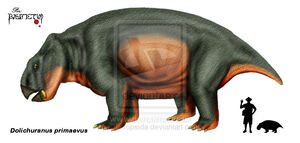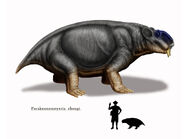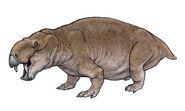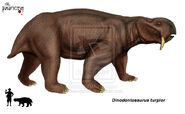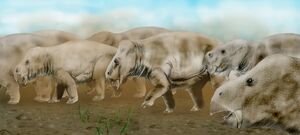
Placerias hesternus, a synapsid kannemeyeriine dicynodont therapsid reptile species.
Kannemeyeriidae is a family of large, stocky, beaked and sometimes tusked dicynodont reptiles descended from ancestors similar to Lystrosaurus. They were the dominant large terrestrial herbivores through most of the Triassic period. Well known genera include: Kannemeyeria, Sinokannemeyeria, Dinodontosaurus, and Placerias.
Ischigualastia[]
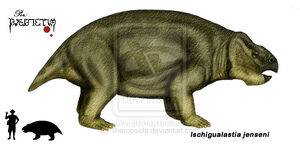
Ischigualastia jenseni.
Ischigualastia jenseni was a dicynodont reptile that lived during the Carnian age of the Late Triassic Period, from the Ischigualasto Formation of Argentina.It is regarded as larger than its later, more famous relative Placerias, which was up to 3.5 meters long (11.5 ft) and weighed one to two tonnes (1.1 to 2.2 short tons). Unlike Placerias, it lacked tusks. It was a large quadrupedal herbivore, most common at the base of the Ischigualasto Formation.
Dolichuranus[]
Dolichuranus is an extinct genus of african dicynodont therapsid reptile from the Middle Triassic.
Species[]
Parakannemeyeria[]
Parakannemeyeria is an extinct dicynodont kannemeyeriine reptile genus.
Species[]
Dinodontosaurus[]
Dinodontosaurus (meaning "terrible-toothed lizard") is a genus of dicynodont therapsid. It was one of the largest herbivores of the Triassic (about 8 feet (2.4 m) long and weighing a few hundred pounds) and had a beak corneum. It lived in the Middle Triassic but disappeared in the Upper Triassic. Dinodontosaurus turpior is the most common species of dicynodont that existed in the Middle Triassic, and more common in the fossil layers that age in Rio Grande do Sul, in geopark of paleorrota. They are found mainly in the Paleontological Site Chiniquá in São Pedro do Sul and Candelária , where a group of ten pupswere found together, demonstrating that these animals had strategies for coexistence in a group and caring for their offspring.
Species[]
Stahleckeria[]
Stahleckeria was a Middle Triassic dicynodont, living about 240 million years ago. It was similar to Kannemeyeria. It's named in honor of Rudolf Stahlecker. This genus was a contemporary of the larger and more common Dinodontosaurus. The differences between Stahleckeria and Dinodontosaurus may reflect adaptations to feeding on different plant species.
Species[]
- Stahleckeria pricei: Given name to an undefined Stahleckeria specimen (Price described this specimen in 1944)

Stahleckeria pricei.

Stahleckeria potens.
- Stahleckeria potens: found in the Santa Maria Formation, Stahleckeria potens measured 4 meters in length and weighed approximately 400 kg. The fossils of Stahleckeria potens are currently in Germany in the museum of the University of Tübingen.
Jachaleria[]
Jachaleria was a dicynodont reptile that lived in the Carnian stage of the Upper Triassic, approximately 220 million years ago. Jachaleria was one of the last representatives of the dicynodonts, occurring in Argentina and Brazil. It lacked teeth, much like Stahleckeria, but was closer in size to Dinodontosaurus.
Species[]
- Jachaleria colorata: this Jachaleria species was found in Argentina, in the Los Colorados Formation. It is very similar to Jachaleria candelariensis.

Jachaleria colorata.

Jachaleria candelariensis.
- Jachaleria candelariensis: is found near Candelária City, in the paleorrota geopark in Brazil. It grew to perhaps 3 meters in length and weighed 300 kilograms. Throughout the early part of the Upper Triassic dicynodonts were absent from the paleorrota and the rhynchosaurs were the dominant herbivores. At the end of Carnian, however, the rhynchosaurs became extinct and the dicynodonts appear in their place. Jachaleria candelariensis occurs in the Caturrita Formation.
Kannemeyeria[]
Kannemeyeria was a large dicynodont of the family Kannemeyeriidae, one of the first representatives of the family, and hence one of the first large herbivores of the Triassic. It lived during the later Early and early Middle part of the Triassic period (from the late Olenekian to the Middle Anisian age). Kannemeyeria was about 3 m (10 ft) in length, about the size of an ox. It was well-adapted to living as a herbivore; it had a powerful beak and strong jaw muscles built for shearing plant material. Although it had a large head, it was lightweight due to the size of the eye sockets and nasal cavity. It also had limb girdles which formed massive plates of bone that helped support its heavily-built body. Various species of the genus Kannemeyeria are known from South Africa, Argentina, India, and (either this or a similar genus) China, and it can be assumed that, like many animals of this time, it had worldwide distribution.
